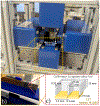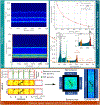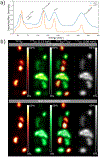Individual and Simultaneous Imaging of 99 m Tc and 177Lu with a Preclinical Broad Energy-Spectrum CZT-based SPECT
- PMID: 40390772
- PMCID: PMC12088624
- DOI: 10.1109/trpms.2025.3527874
Individual and Simultaneous Imaging of 99 m Tc and 177Lu with a Preclinical Broad Energy-Spectrum CZT-based SPECT
Abstract
Radiopharmaceutical therapy has demonstrated a high efficacy in the treatment of various tumor types. One of the radionuclides already used in the clinic is 177Lu, a beta emitter that also emits several photons imageable with SPECT. Quantitative imaging of 177Lu is critical for developing new radiopharmaceuticals. Energy resolution is an important factor when imaging multiple photon emissions. Solid-state detectors offer a superior performance over scintillators, that are commonly used in commercially-available preclinical SPECT scanners. This study demonstrates the feasibility of 99m Tc and 177Lu quantitative imaging in mouse phantoms, individually and simultaneously, with a SPECT prototype built with four CdZnTe (CZT) detector heads and a custom-designed and energy-optimized parallel-hole tungsten collimator. With a custom implementation of the one-step late (OSL) image reconstruction algorithm, the system is capable of imaging energies from ~70 keV to 250 keV. Above 250 keV, images were significantly affected by septal penetration, consistent with the collimator design. A recovery coefficient within 25% was obtained for activities as low as 2 kBq/mL for 99m Tc and 45% for 177Lu. Compared to a commercial NaI-based preclinical SPECT (VECTor4/CT), our prototype showed a superior energy resolution (< 5% at 140 keV), a similar uniformity with a high-compact design.
Keywords: GPU Image Reconstruction; Low activity imaging; Radiopharmaceutical therapy; SPECT; Theranostics.
Figures












Similar articles
-
Simulation studies of a full-ring, CZT SPECT system for whole-body imaging of 99m Tc and 177 Lu.Med Phys. 2023 Jun;50(6):3726-3737. doi: 10.1002/mp.16360. Epub 2023 Mar 22. Med Phys. 2023. PMID: 36916755 Free PMC article.
-
360° CZT-SPECT/CT cameras: 99mTc- and 177Lu-phantom-based evaluation under clinical conditions.EJNMMI Phys. 2024 Oct 24;11(1):89. doi: 10.1186/s40658-024-00684-6. EJNMMI Phys. 2024. PMID: 39446222 Free PMC article.
-
An energy-optimized collimator design for a CZT-based SPECT camera.Nucl Instrum Methods Phys Res A. 2016 Jan 11;806:330-339. doi: 10.1016/j.nima.2015.09.115. Nucl Instrum Methods Phys Res A. 2016. PMID: 26640308 Free PMC article.
-
Evaluation of a variable-aperture full-ring SPECT system using large-area pixelated CZT modules: A simulation study for brain SPECT applications.Med Phys. 2021 May;48(5):2301-2314. doi: 10.1002/mp.14836. Epub 2021 Mar 30. Med Phys. 2021. PMID: 33704793 Free PMC article.
-
Technological Advances in SPECT and SPECT/CT Imaging.Diagnostics (Basel). 2024 Jul 4;14(13):1431. doi: 10.3390/diagnostics14131431. Diagnostics (Basel). 2024. PMID: 39001321 Free PMC article. Review.
References
-
- Cunha L, Horvath I, Ferreira S, Lemos J, Costa P, Vieira D, Veres DS, Szigeti K, Summavielle T, Máthé D et al., “Preclinical imaging: an essential ally in modern biosciences,” Molecular diagnosis & therapy, vol. 18, pp. 153–173, 2014. - PubMed
-
- Li Z, Benabdallah N, Abou DS, Baumann BC, Dehdashti F, Ballard DH, Liu J, Jammalamadaka U, Laforest RL, Wahl RL, Thorek DLJ, and Jha AK, “A projection-domain low-count quantitative spect method for -particle-emitting radiopharmaceutical therapy,” IEEE Transactions on Radiation and Plasma Medical Sciences, vol. 7, no. 1, pp. 62–74, 2023. - PMC - PubMed
-
- Goorden MC, van der Have F, Kreuger R, Ramakers RM, Vastenhouw B, Burbach JPH, Booij J, Molthoff CF, and Beekman FJ, “Vector: a preclinical imaging system for simultaneous submillimeter spect and pet,” Journal of Nuclear Medicine, vol. 54, no. 2, pp. 306–312, 2013. - PubMed
Grants and funding
LinkOut - more resources
Full Text Sources
Miscellaneous
